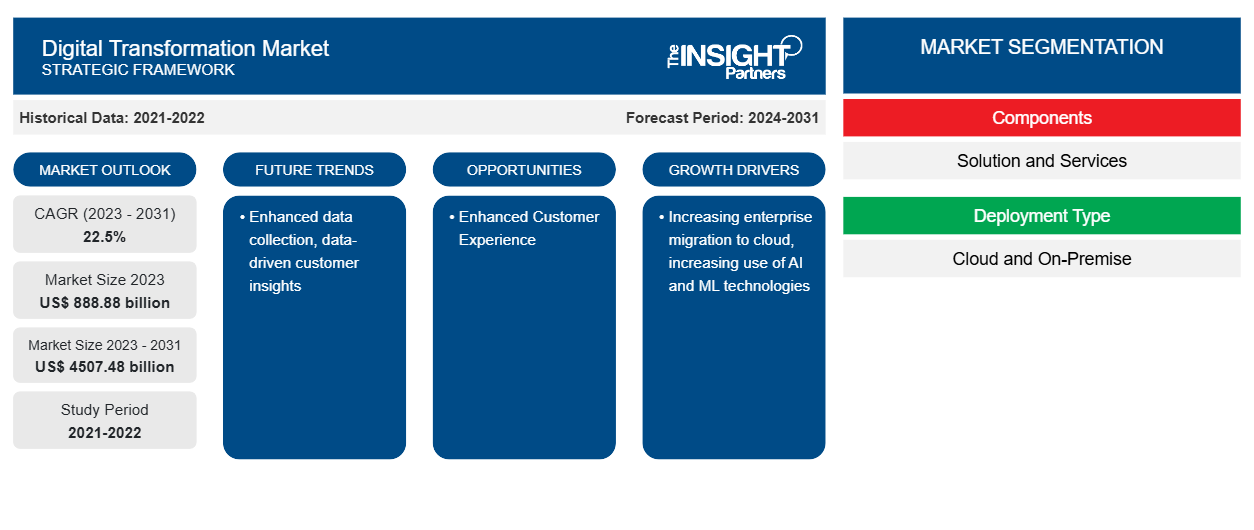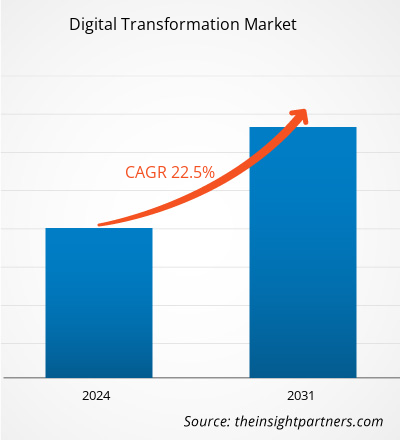The Digital Transformation market size is projected to reach US$ 4507.48 billion by 2031 from US$ 888.88 billion in 2023. The market is expected to register a CAGR of 22.5% in 2023–2031. Enhanced data collection and data-driven customer insights are likely to remain key Digital Transformation market trends.
Digital Transformation Market Analysis
In the continuously evolving global enterprise operations, digital transformation has become imperative for businesses to stay relevant and efficient in the market. All organizations, be they small or large, are increasingly moving towards streamlining their operation by migrating to the cloud. Delivering customer value requires integrating digital technologies in every business area. This is driving the market growth.
Digital Transformation Market Overview
As per the projections published by the World Economic Forum, US$ 100 trillion will be infused by digital transformation into the world economy by 2025. Digital strategy has been adopted by organizations across the globe to increase success rates.
Customize This Report To Suit Your Requirement
You will get customization on any report - free of charge - including parts of this report, or country-level analysis, Excel Data pack, as well as avail great offers and discounts for start-ups & universities
Digital Transformation Market: Strategic Insights

-
Get Top Key Market Trends of this report.This FREE sample will include data analysis, ranging from market trends to estimates and forecasts.
Digital Transformation Market Drivers and Opportunities
Increasing Enterprise Migration to Cloud to Favor Market
Cloud migration strategy by enterprises can be understood as the movement from on-premise infrastructure to a virtual service offering on-demand scalability, computing, storage, and network services, among others. In this digitizing economy, enterprises realize the need for speed and cost saving, disaster recovery, and constantly updating new tech. According to a 2022 Google Cloud Brand Pulse Survey, investments in cloud-based services and tech are the aim of around 41.4% of the global tech and business leaders in order to sustain in the highly competitive market. This is driving the growth of the digital transformation market.
Enhanced Customer Experience - An Opportunity in the Digital Transformation Market
The rising wave of digital transformation ought to enhance customer experience by making it more seamless and intuitive. This can be achieved by shortening the response time of outreach to customers. Customer expect high standards in their online presence. Brands are competing in the enhancing CX by offering affordable rates, and quick delivery. This has been possible due to rising digital transformation.
Digital Transformation Market Report Segmentation Analysis
Key segments that contributed to the derivation of the Digital Transformation Market analysis are components, deployment type, and application.
- Based on components, the digital transformation market is divided into solution and services.
- Based on the deployment type, the digital transformation market is divided into cloud and on-premise. The cloud segment held the largest share of the market in 2023.
- Based on the application, the digital transformation market is divided into BFSI, healthcare, education, retail, IT & telecom, logistics & transportation, manufacturing, and others.
Digital Transformation Market Share Analysis by Geography
The geographic scope of the Digital Transformation Market report is mainly divided into five regions: North America, Asia Pacific, Europe, Middle East & Africa, and South America/South & Central America.
North America has dominated the Digital Transformation market. The region’s dominance can be attributed to the presence of top information technology providers in the world. The US has around 5,381 data centers providing connectivity to over 19,000 service providers.
Digital Transformation Market Regional InsightsThe regional trends and factors influencing the Digital Transformation Market throughout the forecast period have been thoroughly explained by the analysts at The Insight Partners. This section also discusses Digital Transformation Market segments and geography across North America, Europe, Asia Pacific, Middle East and Africa, and South and Central America.
Digital Transformation Market Report Scope
| Report Attribute | Details |
|---|---|
| Market size in 2023 | US$ 888.88 billion |
| Market Size by 2031 | US$ 4507.48 billion |
| Global CAGR (2023 - 2031) | 22.5% |
| Historical Data | 2021-2022 |
| Forecast period | 2024-2031 |
| Segments Covered |
By Components
|
| Regions and Countries Covered |
North America
|
| Market leaders and key company profiles |
|
Digital Transformation Market Players Density: Understanding Its Impact on Business Dynamics
The Digital Transformation Market is growing rapidly, driven by increasing end-user demand due to factors such as evolving consumer preferences, technological advancements, and greater awareness of the product's benefits. As demand rises, businesses are expanding their offerings, innovating to meet consumer needs, and capitalizing on emerging trends, which further fuels market growth.

- Get the Digital Transformation Market top key players overview
Digital Transformation Market News and Recent Developments
The Digital Transformation Market is evaluated by gathering qualitative and quantitative data post-post-primary and secondary research, which includes important corporate publications, association data, and databases. The following is a list of developments in the market for Digital Transformation Market and strategies:
- Salam, which was previously known as Integrated Telecom Company, announced the selection of Oracle to drive 5G innovation across the Middle East. The company is considered one of the most innovative telecom brands showing fast growth. The company will utilize Oracle Communications’ monetization and unified operations solutions to help quickly deliver differentiated services to its consumer and enterprise customers. (Source: Oracle Corporation, Press Release, 2023)
Digital Transformation Market Report Coverage and Deliverables
The “Digital Transformation Market Size and Forecast (2021–2031)” report provides a detailed analysis of the market covering below areas:
- Market size and forecast at global, regional, and country levels for all the key market segments covered under the scope
- Market dynamics such as drivers, restraints, and key opportunities
- Key future trends
- Detailed PEST/Porter’s Five Forces and SWOT analysis
- Global and regional market analysis covering key market trends, major players, regulations, and recent market developments
- Industry landscape and competition analysis covering market concentration, heat map analysis, prominent players, and recent developments
- Detailed company profiles
Frequently Asked Questions
Which deployment type segment held the major share in 2023?
Which are the key players holding the major market share of the global Digital Transformation market?
What are the future trends of the global Digital Transformation Market?
What are the driving factors impacting the global Digital Transformation market?
What is the estimated market size for the global Digital Transformation market in 2023?
- Historical Analysis (2 Years), Base Year, Forecast (7 Years) with CAGR
- PEST and SWOT Analysis
- Market Size Value / Volume - Global, Regional, Country
- Industry and Competitive Landscape
- Excel Dataset
Recent Reports
Related Reports
Testimonials
Reason to Buy
- Informed Decision-Making
- Understanding Market Dynamics
- Competitive Analysis
- Identifying Emerging Markets
- Customer Insights
- Market Forecasts
- Risk Mitigation
- Boosting Operational Efficiency
- Strategic Planning
- Investment Justification
- Tracking Industry Innovations
- Aligning with Regulatory Trends





















 Get Free Sample For
Get Free Sample For